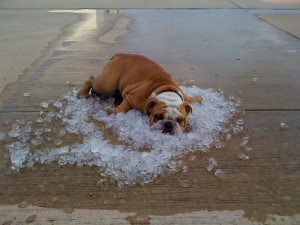Hot Weather Tips for Cats & Dogs – Stay Safe. Stay Healthy. Stay Happy!
From: Pet Sit Pros Made in the Shade Pets can get dehydrated quickly, so give them plenty of fresh, clean water when it’s hot outdoors. Make sure the pets have a shady place to get out of the sun, be careful to not over-exercise them, and keep them indoors when it’s extremely hot.
Know the Warning Signs Symptoms of overheating in pets include excessive panting or difficulty breathing, increased heart and respiratory rate, drooling, mild weakness, stupor or even collapse. They can also include seizures, bloody diarrhea and vomit along with an elevated body temperature of over 104 degrees. Animals with flat faces, like Pugs and Persian cats, are more susceptible to heat stroke since they cannot pant as effectively. These pets, along with the elderly, the overweight, and those with heart or lung diseases, should be kept cool in air-conditioned rooms as much as possible.
Be cautious on humid days. Humidity interferes with animals’ ability to rid them of excess body heat. When we overheat we sweat, and when the sweat dries it takes excess heat with it. Our four-legged friends only perspire around their paws, which is not enough to cool the body. To rid themselves of excess heat, animals pant. Air moves through the nasal passages, which picks up excess heat from the body. As it is expelled through the mouth, the extra heat leaves along with it. Although this is a very efficient way to control body heat, it is severely limited in areas of high humidity or when the animal is in close quarters.
Make sure the pet doesn’t overexert herself. Though exercise is an important part of keeping the dog or cat at a healthy weight, which helps their body stay cool, overdoing it can cause them to overheat. Keep the walks to a gentle pace and make sure they have plenty of water. If they are panting a lot or seems exhausted, it’s time to stop.
Take it easy on pets that can’t deal with the heat. Elderly, very young, and ill animals have a hard time regulating their body temperature, so make sure they stay cool and out of the sun on steamy summer days. Dogs with snub noses, such as Pekingese, pugs, and bulldogs, have a hard time staying cool because they can’t pant efficiently, so they also need to stay out of the heat. Overweight dogs are also more prone to overheating, because their extra layers of fat act as insulation, which traps heat in their bodies and restricts their breathing capabilities.
Bring them inside. Animals shouldn’t be left outside unsupervised on long, hot days, even in the shade. Shade can move throughout the afternoon, and pets can become ill quickly if they overheat, so keep them inside as much as possible. If you must leave the pet in the backyard, keep a close eye on them and bring them in when you can.
Keep an eye out for heatstroke. Heatstroke is a medical emergency. If you suspect the pet has heatstroke (see “Signs of Heatstroke,” below), you must act quickly and calmly. Have someone call a veterinarian immediately. In the meantime, lower the animal’s body temperature by applying towels soaked in cool water to the hairless areas of the body. Often the pet will respond after only a few minutes of cooling, only to falter again with his temperature soaring back up or falling to well below what is normal. With this in mind, remember that it is imperative to get the animal to a veterinarian immediately.
Even with emergency treatment, heatstroke can be fatal. The best cure is prevention, and Fido and Fluffy are relying on you to keep them out of harm’s way. Summer does not have to be fraught with peril…with ample pre-caution; both you and your furry friends can enjoy those long, hot dog days of summer.
Made in the Shade Pets can get dehydrated quickly, so give them plenty of fresh, clean water when it’s hot outdoors. Make sure the pets have a shady place to get out of the sun, be careful to not over-exercise them, and keep them indoors when it’s extremely hot.
Know the Warning Signs Symptoms of overheating in pets include excessive panting or difficulty breathing, increased heart and respiratory rate, drooling, mild weakness, stupor or even collapse. They can also include seizures, bloody diarrhea and vomit along with an elevated body temperature of over 104 degrees. Animals with flat faces, like Pugs and Persian cats, are more susceptible to heat stroke since they cannot pant as effectively. These pets, along with the elderly, the overweight, and those with heart or lung diseases, should be kept cool in air-conditioned rooms as much as possible.
Be cautious on humid days. Humidity interferes with animals’ ability to rid them of excess body heat. When we overheat we sweat, and when the sweat dries it takes excess heat with it. Our four-legged friends only perspire around their paws, which is not enough to cool the body. To rid themselves of excess heat, animals pant. Air moves through the nasal passages, which picks up excess heat from the body. As it is expelled through the mouth, the extra heat leaves along with it. Although this is a very efficient way to control body heat, it is severely limited in areas of high humidity or when the animal is in close quarters.
Make sure the pet doesn’t overexert herself. Though exercise is an important part of keeping the dog or cat at a healthy weight, which helps their body stay cool, overdoing it can cause them to overheat. Keep the walks to a gentle pace and make sure they have plenty of water. If they are panting a lot or seems exhausted, it’s time to stop.
Take it easy on pets that can’t deal with the heat. Elderly, very young, and ill animals have a hard time regulating their body temperature, so make sure they stay cool and out of the sun on steamy summer days. Dogs with snub noses, such as Pekingese, pugs, and bulldogs, have a hard time staying cool because they can’t pant efficiently, so they also need to stay out of the heat. Overweight dogs are also more prone to overheating, because their extra layers of fat act as insulation, which traps heat in their bodies and restricts their breathing capabilities.
Bring them inside. Animals shouldn’t be left outside unsupervised on long, hot days, even in the shade. Shade can move throughout the afternoon, and pets can become ill quickly if they overheat, so keep them inside as much as possible. If you must leave the pet in the backyard, keep a close eye on them and bring them in when you can.
Keep an eye out for heatstroke. Heatstroke is a medical emergency. If you suspect the pet has heatstroke (see “Signs of Heatstroke,” below), you must act quickly and calmly. Have someone call a veterinarian immediately. In the meantime, lower the animal’s body temperature by applying towels soaked in cool water to the hairless areas of the body. Often the pet will respond after only a few minutes of cooling, only to falter again with his temperature soaring back up or falling to well below what is normal. With this in mind, remember that it is imperative to get the animal to a veterinarian immediately.
Even with emergency treatment, heatstroke can be fatal. The best cure is prevention, and Fido and Fluffy are relying on you to keep them out of harm’s way. Summer does not have to be fraught with peril…with ample pre-caution; both you and your furry friends can enjoy those long, hot dog days of summer.
Signs of Heatstroke:
* Panting
* Staring
* Anxious expression
* Refusal to obey commands
* Warm, dry skin







